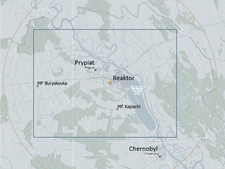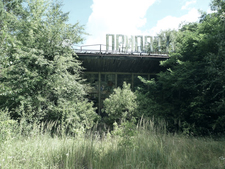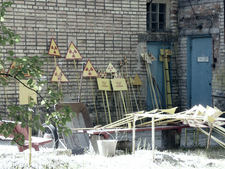-
Topics
subnavigation
Topics
Electromagnetic fields
- What are electromagnetic fields?
- Static and low-frequency fields
- Radiation protection relating to the expansion of the national grid
- High-frequency fields
- Radiation protection in mobile communication
Optical radiation
Ionising radiation
- What is ionising radiation?
- Radioactivity in the environment
- Applications in medicine
- Applications in daily life and in technology
- Effects
- What are the effects of radiation?
- Effects of selected radioactive materials
- Consequences of a radiation accident
- Cancer and leukaemia
- Genetic radiation effects
- Individual radiosensitivity
- Epidemiology of radiation-induced diseases
- Ionising radiation: positive effects?
- Risk estimation and assessment
- Radiation protection
- Nuclear accident management
- Service offers
-
The BfS
subnavigation
The BfS
- About us
- Science and research
- Laws and regulations
- BfS Topics in the Bundestag
- Links
Measurement exercise 2016 in Ukraine
- From 26 to 29 September 2016, employees of the BfS conducted a measurement exercise together with staff members of the State Nuclear Regulatory Inspectorate of Ukraine in the 30-kilometre-zone around the nuclear power plant in Chernobyl (Ukraine).
- The measurements were carried out in the areas around Kapachi, Buryakovka and the city of Pripyat.
- In addition to the training of radioactivity measurements under particular conditions, the measurement exercise contributed to updating the characterisation of the radiological situation around the Chernobyl nuclear power plant.
From 26 to 29 September 2016, employees of the Federal Office for Radiation Protection (BfS) conducted a measurement exercise together with staff members of the State Nuclear Regulatory Inspectorate of Ukraine in the 30-kilometre-zone around the nuclear power plant in Chernobyl (Ukraine).
The measurements were carried out in the areas around Kapachi, Buryakovka and the city of Pripyat. The BfS measurement teams were made up of 26 staff members from the six BfS locations.

![]() 30-kilometre-zone of the Chernobyl reactor with the measurement area outlined (rectangle) and location of the two measurement fields Kapachi and Buryakovka
Source: OpenStreetMap; QGIS 2016
30-kilometre-zone of the Chernobyl reactor with the measurement area outlined (rectangle) and location of the two measurement fields Kapachi and Buryakovka
Source: OpenStreetMap; QGIS 2016
What was the aim of the measurement exercises?
On the one hand, the participants practised measuring radioactivity under particular conditions. On the other hand, the measurement exercise contributed to updating the characterisation of the radiological situation in the 30-kilometre-zone around the Chernobyl nuclear power plant. Further aims of the measurement exercise were
- the performance of comparative measurements using different measurement systems,
- practical education and training of personnel for working under conditions with elevated levels of ionising radiation,
- realistic working conditions with protective equipment in contaminated areas,
- transnational cooperation in measurements and joint scientific evaluation of the data.
How was the exercise carried out and what was measured?
The following teams participated in the exercise:
- four BfS teams with in situ measurement vehicles,
- six BfS teams with ODL (ambient dose rate) measurement vehicles,
- one BfS team with an airborne measurement system (UAV--unmanned aerial vehicle) and
- several measurement teams on the part of Ukraine.
During the exercise, the activity on ground surfaces was measured using in situ measurements (actually "in situ gamma spectrometry") and the gamma radiation levels in the vicinity were determined by ambient dose rate (ODL) measurements.
Measurement groups were formed from the measurement teams depending on the measurement tasks. Supplementary measurements were performed with the UAV--unmanned aerial vehicle.

![]() Abandoned building in Pripyat harbour
Abandoned building in Pripyat harbour
The measurements in detail
- area measurement jointly performed by all teams in order to determine the ambient dose rate (ODL) and the contamination level of the soil (in situ measurement) in two areas around Kapachi and Buryakovka
- large-scale radiological survey in five different areas around the Chernobyl nuclear power plant during which the measurement groups worked independently of one another
- radiological survey in urban areas using vehicle- and backpack-borne ambient dose rate (ODL) measuring systems and in situ measurements
In order to be able to state to what extent a measurement vehicle shields against radiation (shielding factor), one measurement was conducted at a suitable spot inside the measurement vehicle and a comparative measurement outside the vehicle. Knowing the shielding factors, which are determined in the process, is of fundamental interest in the interpretations of measurement results obtained by vehicle-borne systems.
During the course of the entire exercise, the teams on site were supported by BfS staff members in Germany.
First verification and evaluation of the measurement data
On the last day of the stay, a first on-site evaluation of the data was made. Both the cooperation with the Ukrainian experts as well as the support by BfS staff members in Germany were field-tested internationally on the occasion.
Was there a hazard for the measurement teams during the measurement exercise?

![]() Workshop producing warning signs for the exclusion zone
Workshop producing warning signs for the exclusion zone
The exercise was conducted under the supervision of the Ukrainian State Nuclear Regulatory Committee, that is, all participants of the exercise were subject to local radiation protection organised on the part of Ukraine.
The ambient dose rates (ODL) typically measured on the survey route (by vehicle or on foot) during the measurement exercise ranged from 2 to 50 microsieverts per hour. Individual areas with levels of up to 200 microsieverts per hour were avoided. For comparison purposes: The ambient dose rate (ODL) in Germany is usually between 0.05 and 0.25 microsievert per hour and the dose rate in a commercial airliner at cruising altitude up to 11 microsieverts per hour.
Upon leaving the exclusion zone, vehicles are checked for possible contamination. Transport regulations and provisions of the German Radiation Protection Ordinance were complied with during the entire exercise and also during preparation and follow-up time.
State of 2018.02.23


